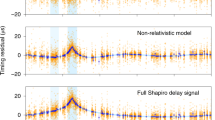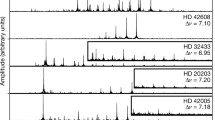Abstract
ONE or more planets may be orbiting the pulsar in the Crab Nebula. Richards et al.1 inferred the presence of a planet from the sinusoidal behaviour of the residuals in the pulse arrival time data of NP 0532 after the first and second derivatives of the pulsar period had been removed. The sinusoidal character of the residuals has, however, been queried2,3. Michel4 has attributed the period discontinuity observed last autumn5,6 (the so-called “glitch”) to a planet in a highly eccentric orbit sweeping close to the pulsar. And the Princeton group7 have tentatively fitted their pulse arrival time residuals by invoking three planets!
This is a preview of subscription content, access via your institution
Access options
Subscribe to this journal
Receive 51 print issues and online access
$199.00 per year
only $3.90 per issue
Buy this article
- Purchase on Springer Link
- Instant access to full article PDF
Prices may be subject to local taxes which are calculated during checkout
Similar content being viewed by others
References
Richards, D. W., Pettengill, G. H., Counselman, C. C., and Rankin, J., Intern. Astron. Union. Circ., No. 2178 (1969).
Nelson, J., Hills, R., Cudaback, D., and Wampler, J., Astrophys. J., 161, L235 (1970).
Roberts, J. A., Intern. Astron. Union Crab Nebula Symp. (edit. by Davies, R. D. and Smith, F. G.) (Reidel, in the press).
Michel, F. C., Astrophys. J., 159, L25 (1970).
Boynton, P. E., Groth, E. J., Partridge, R. B., and Wilkinson, D. T., Intern. Astron. Union Circ., No. 2179 (1969).
Richards, D. W., Pettengill, G. H., Roberts, J. A., Counselman, C. C., and Rankin, J., Intern. Astron. Union Circ., No. 2181 (1969).
Wilkinson, D. T., Intern. Astron. Union Crab Nebula Symp. (edit. by Davies, R. D. and Smith, F. G.) (Reidel, in the press).
Scargle, J. D., and Harlan, E. A., Astrophys. J., 159, L143 (1969).
Rankin, J., Intern Astron. Union Crab Nebula Symp. (edit. by Davies, R. D. and Smith, F. G.) (Reidel, in the press).
Iben, I., Astrophys. J., 142, 1447 (1965).
Gott, J. R., Gunn, J. E., and Ostriker, J. P., Astrophys. J., 160, L91 (1970).
Davidson, K., and Tucker, W., Astrophys. J., 161, 437 (1970).
Minkowski, R., Nebulae and Interstellar Matter (edit. by Aller, L. H. and Middlehurst, B. M.) (Chicago, 1968).
Colgate, S. A., Nature, 225, 247 (1970).
Ostriker, J. P., and Gunn, J. E., Astrophys. J., 157, 1395 (1969).
Trimble, V. L., and Rees, M. J., Astrophys. Lett., 5, 93 (1970).
Rees, M. J., Intern. Astron. Union Crab Nebula Symp. (edit. by Davies, R. D. and Smith, F. G.) (Reidel, in the press).
Scargle, J. D., Astrophys. J., 156, 401 (1969).
Author information
Authors and Affiliations
Rights and permissions
About this article
Cite this article
REES, M., TRIMBLE, V. & COHEN, J. Physical Sciences: Planet, Pulsar, “Glitch” and Wisp. Nature 229, 395–396 (1971). https://doi.org/10.1038/229395a0
Received:
Issue Date:
DOI: https://doi.org/10.1038/229395a0
This article is cited by
-
Alteration of the magnetosphere of the Vela pulsar during a glitch
Nature (2018)
-
A planet orbiting the neutron star PSR1829–10
Nature (1991)
-
The crab nebula
Astrophysics and Space Science (1973)
-
On the Mechanism of the Glitches in the Crab Nebula Pulsar
Nature Physical Science (1971)
Comments
By submitting a comment you agree to abide by our Terms and Community Guidelines. If you find something abusive or that does not comply with our terms or guidelines please flag it as inappropriate.



